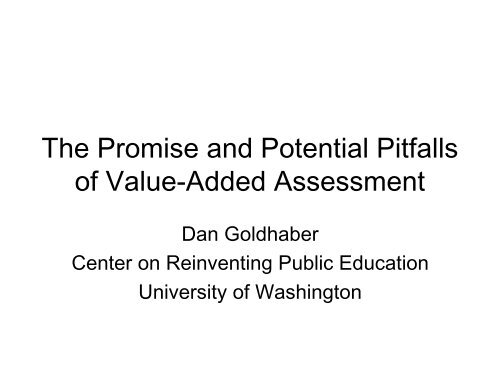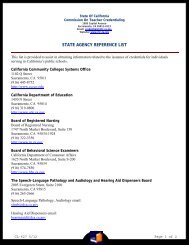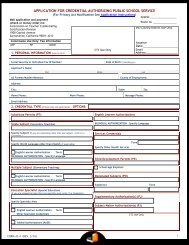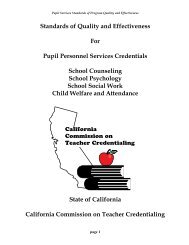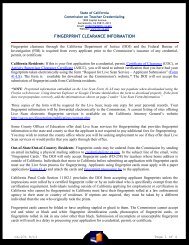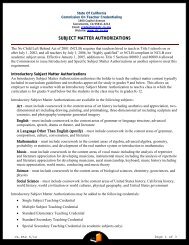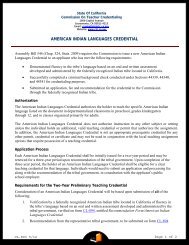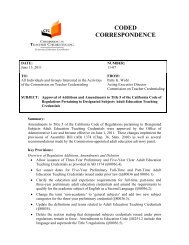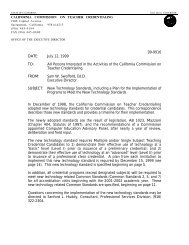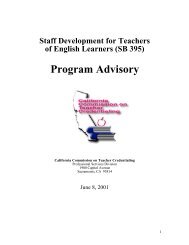The Promise and Potential Pitfalls of Value-Added Assessment
The Promise and Potential Pitfalls of Value-Added Assessment
The Promise and Potential Pitfalls of Value-Added Assessment
- No tags were found...
You also want an ePaper? Increase the reach of your titles
YUMPU automatically turns print PDFs into web optimized ePapers that Google loves.
<strong>The</strong> <strong>Promise</strong> <strong>and</strong> <strong>Potential</strong> <strong>Pitfalls</strong><strong>of</strong> <strong>Value</strong>-<strong>Added</strong> <strong>Assessment</strong>Dan GoldhaberCenter on Reinventing Public EducationUniversity <strong>of</strong> Washington
Just in Case…• <strong>The</strong>re are potentially a lot <strong>of</strong> problems with usingVAM for policy purposes– Inadequate teacher quality measures <strong>and</strong> inappropriateuses <strong>of</strong> measures may create perverse incentives <strong>and</strong>certainly political strife• <strong>The</strong>re’s a fair amount that we don’t know aboutusing VAM• But, if I had to make a call– Just as “democracy is the worst form <strong>of</strong> governmentexcept all the others that have been tried”… VAM isn’tperfect, but it looks good relative to alternatives (at leastwith the current institutional structure/culture <strong>of</strong> publicschools)2
A Simple Observation• Opposition to VAM arises not from intrinsicopposition to statistical approach, but in howit might be used• Thus, this presentation is focused on VAM inthe context <strong>of</strong> it’s potential uses– Directing pr<strong>of</strong>essional development– Factor in pay– Determining employment3
Do We Care About Test Scores?• <strong>The</strong> problem: all tests sample imprecisely overvarious domains• But, there is a large literature showing that varioustests predict– College-going behavior, employment probability,earnings, <strong>and</strong> a host <strong>of</strong> other non-financial measures <strong>of</strong>well-being– National competitiveness (Hanushek et al., 2008)Some question <strong>of</strong> causality, but I would argue theevidence is pretty definitive that tests are importantmeasures4
Gateway vs. Workforce PoliciesEmpirical arguments for teacher workforce policies:1. (Easily quantifiable) teacher characteristics usedto determine teachers’ employment eligibility <strong>and</strong>compensation don’t strongly predict teachereffectiveness2. Teachers are more different than alike: thedifferences between the best <strong>and</strong> worst teacherswho hold a particular credential swamp thedifferences between those with <strong>and</strong> without thecredential5
But… Significant <strong>Potential</strong>Problems with Using VAM• Logistical issues• Perverse incentives/unintendedconsequences• Test measurement issues• <strong>The</strong>oretical/practical issues measuringteacher contributions• Defining the constructed counterfactual6
Logistical Issues• Timing <strong>of</strong> tests– Summer fall-back– Administration mid-year• Student absences• Data constraints– In most places data systems are not now set up for highstakesVAM purposes• To get more credible estimates <strong>of</strong> teacher contribution we needmultiple years <strong>of</strong> student background information linked toteachers• To use VAM effectively, we probably need VAM estimatessooner7
Perverse Incentives/UnintendedConsequences• Forgo non-tested outcomes (history, music,tolerance, democracy, etc.)– Less than 20% <strong>of</strong> K-12 instruction is in tested areas• Narrowing <strong>of</strong> instruction to unimportant test skillsnot associated with comprehension– We <strong>of</strong>ten see large gains on state assessments when anew test is introduced (not confirmed by NAEP)• Discourage collaboration amongst teachers• Corruption– Hiding <strong>of</strong> low-growth students– Cheating8
Test Measurement Issues• Vertical alignment <strong>of</strong> tests & floor <strong>and</strong> ceiling effects• Tests are noisy measures <strong>of</strong> student knowledge– Precision <strong>of</strong> estimate <strong>of</strong> teacher value added will dependon number <strong>of</strong> students taught (class size <strong>and</strong>/or # years<strong>of</strong> data in VAM)• Kane & Staiger (2001) find probability <strong>of</strong> falling into tails <strong>of</strong> thedistribution is inversely related to school size (small schools morelikely to be rewarded or sanctioned because <strong>of</strong> statistical noise)• Estimates (e.g. Ballou, 2005) suggest that only 2.5 (reading) <strong>and</strong>17 (math) percent <strong>of</strong> 1-year teacher effect estimates arestatistically significant, but 3-year estimates roughly triple thepercentage <strong>of</strong> statistically significant effects– Imprecision means that “cut-point policies” will alwaysresult in errors9
Measuring Teachers• We don’t really know how to h<strong>and</strong>le:– Teachers who are effective in one area <strong>and</strong> notanother– Multiple teachers, complementary subjects <strong>and</strong>apportioning credit– Out <strong>of</strong> grade teacher contributions10
Defining the Counterfactual• We never directly observe the counterfactual <strong>of</strong>interest– VAM should account for:1. Observed differences in student background/skills2. Observed differences in school quality <strong>and</strong> peer effects3. Unobservables related to the nonr<strong>and</strong>om distribution <strong>of</strong>students <strong>and</strong> teachers• Failure to account for any <strong>of</strong> the above threeissues can lead to biased VAM estimates11
What We Do Know About VAMs?• Relatively few teacher effects are statistically different frommean effect• Year-to-year correlation <strong>of</strong> teacher effects is in the range <strong>of</strong>.2 to .3• VAM models accurately estimate teacher performance inthe absence <strong>of</strong> detailed student background information, butonly if there is significant mixing <strong>of</strong> students across teachers(McCaffrey et al., 2004)• VAMs fail various falsification tests (Rothstein, 2008)• Experimental VAM estimates look similar tononexperimental estimates with particular specifications(Kane <strong>and</strong> Staiger, 2008)12
Trade<strong>of</strong>fs• Multiple years <strong>of</strong> job performance data certainlyimproves reliability <strong>of</strong> estimates– More information & ability to use more sophisticatedstatistical approaches• But, no VAM information on first-year teachers & potentialdampening <strong>of</strong> performance incentives• Comparisons within <strong>and</strong> between schools• May be few good within district comparisons (in small districts)but allows districts to implement policies (sample issue)• Within <strong>and</strong> between school comparisons conflate school <strong>and</strong>teacher effects but effective teacher in one school might havebeen ineffective in another (statistical approach issue)– Decisions about comparisons have potentially importantpolicy implications for level <strong>of</strong> policy implementation• States could assist by estimating VAMs, but leaving it up tolocalities to decide how to use the estimates13
Arguments for Using VAM For PayPurposes• VAM may draw different people into teaching addressing thelong-term downward trend in the academic skills <strong>of</strong> the U.S.teacher workforce• If the desire is to reward teachers who produce high valueaddedthen employing a credentials-based strategy will leadto significant errors (experience, degrees, NBCTs)• Few examples <strong>of</strong> long-st<strong>and</strong>ing programs, but recentempirical work shows that pay for performance increasesstudent achievement (e.g. Figlio <strong>and</strong> Kenny, 2006; Lavy,2002, 2004)14
Current Salary Structure Isn’t WorkingWell• To bring most academically pr<strong>of</strong>icient individuals intoteachingOn average, teachers:– Graduate from less-selective undergraduate institutions, have lowerst<strong>and</strong>ardized test scores (Ballou, 1996; Goldhaber <strong>and</strong> Liu, 2003;Hanushek <strong>and</strong> Pace, 1995), <strong>and</strong> require more remediation in college(U.S. Department <strong>of</strong> Education, 1996)• “College graduates with high test scores are less likely totake [teaching] jobs, employed teachers are less likely tostay, <strong>and</strong> former teachers with high test scores are less likelyto return” (Murnane, et al., 1991)15
Thoughts on VAM in Practice• For policy purposes we probably don’t care aboutprecise estimates <strong>of</strong> teacher effects– We care about where in the effectiveness distributionteachers fall– VAM estimates can be wrong, but not so wrong that theyradically change the estimated teacher effectivenessdistribution– We don’t know much about how or whether VAM errorsinfluence where teachers fall in the distribution• Are we holding VAM to a higher st<strong>and</strong>ard?– Estimates <strong>of</strong> productivity may be as imprecise <strong>and</strong> varyas much in the private sector16
Why VAM?Devil You Don’t Know Is Preferable• We need to try different approaches– Substantial evidence that we currently make badinvestments• MA pay premium• Pr<strong>of</strong>essional development– Stubborn problems with student achievement• Only spotty <strong>and</strong> modest improvement over time, despitesignificant increases in spending on K-12 schools• Large achievement gaps between various groups still exist• U.S. students substantially lagging in international comparisons17
Alternative is Far from a Utopia• More holistic assessment (complementing VAM)would be nice, but…– Structural impediments to serious evaluation– Mistrust <strong>of</strong> subjective judgments• How did we get here?– Accountability <strong>and</strong> st<strong>and</strong>ards movement: publicdissatisfaction with schools (students graduating fromhigh school without basic literacy or numeracy skills)– Policymakers hope: VAM is objective evaluation tool,which allows schools to do what they did not do left totheir own devices• I would prefer using VAM, even with potentialproblems, if the alternative is no serious evaluation18(with consequences) <strong>of</strong> teachers
Hypothetical Relationship Between TeacherLicensure Test Performance <strong>and</strong> Teacher Qualityback19
Teacher Quality Appears to bePrimarily “Unobservable”back20
Comparison <strong>of</strong> Teacher Effects in Mathby Passing Statusback
Experience Levels1st year mean-2nd year mean: 0.059** sd2st year mean-3nd year plus mean: 0.026* sd1st year mean-2nd year mean: 0.050* sd2st year mean-3nd year plus mean: 0.039** sdback degrees22
Degree LevelsDifference in means: .005 sdDifference in means: .014 sdback experience23
NBPTS Certification StatusDifference in means: 0.19** sd <strong>of</strong> teacher qualityback degrees experience24
Individual & Institutional SAT Scores =58 =42Source: Baccalaureate <strong>and</strong> Beyondback25
What Would It Cost To Raise TeacherSalaries To That Of Other Pr<strong>of</strong>essionals?1999AverageAnnualSalary% Increase InTeacherSalaryTotal NecessarySpending OnEducationNeededSpending PerPupilTeacher$48,689--$355 billion$6,508FamilyPhysician$133,900175%$597 billion$12,734Full Pr<strong>of</strong>essor$78,83062%$441 billion$9,412Attorney$69,10442%$413 billion$8,826Engineer$68,29440%$411 billion$8,777Source: AFT Salary Survey 200026
Pay Structure Outside Education• Labor market differentially rewards skills <strong>and</strong>productivity• Important “recent” changes under the surface– Many occupations once closed <strong>of</strong>f to women <strong>and</strong>minorities no longer are– Returns to college quality <strong>and</strong> technical college skills(degree major) have increased• <strong>The</strong>re is an increasing return to graduating from a top collegeor university (Brewer et al., 1999)• <strong>The</strong>re is an increase in the gap (in entry-level salaries)between education <strong>and</strong> technical majors (Grogger & Eide,1995)27


